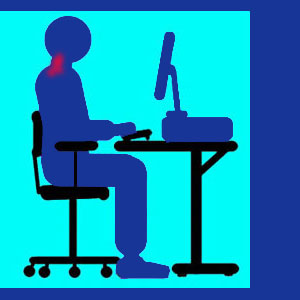
Using a specially designed neck pain chair might help mitigate symptoms while sitting. Seated postures are known to exacerbate many types of dorsalgia, particularly lower back pain problems. However, many neck pain sufferers also complain of heightened pain from extended periods of sitting down. Some of these patients might be able to manage their own symptoms simply by changing or adjusting their chair.
Ergonomic chairs comprise a huge industry, with designs ranging drastically in quality, comfort and price. Chair comfort is subjective, meaning that no single chair will fulfill the needs of every patient. Remember this when shopping for a chair so that you are not overly swayed by sales pitch, marketing or company “research”. Instead, you must find relief when using the chair or it will turn out to be a very disappointing investment.
This consumer guide helps neck pain patients to navigate the ergonomic chair marketplace and find the best seating product for their needs. We will examine a plethora of different chair designs and provide our experiences from tradeshows, as well as first and third person reviews of many of the most popular seating solutions.
Styles of Neck Pain Chairs
Ergonomic chairs come in a wide assortment of styles, materials and design applications. Most chairs are geared towards work use, although some chairs might be marketed mostly for leisure sitting. Chairs that are specifically made to reduce neck pain fall into the following categories:
Traditional office chairs will generally have a seat, back and arms with several adjustments to customize the seating features. Neck pain sufferers often gravitate toward high-backed chairs with headrests to eliminate strain on the neck from long periods of sitting. Of all the available styles, office chairs certainly have the widest range of prices and options.
Kneeling chairs do not support the neck, but instead place the body in a more neutral position that might help decrease gravitational and posture-related strain on the neck.
Standing chairs allow the patient to basically stand and only place some of their weight on a high slanted stool surface. Some patients find the straighter position of standing to be more comfortable when working for a long period of time at a desk or computer. Many of these chairs can also be adjusted to provide traditional counter-height sitting applications.
Facts About Chairs for Neck Pain Problems
Kneeling chairs are niche market items that have not enjoyed universal acceptance by patients or doctors. Some people love kneeling chairs, while others detest them and can not use them comfortably at all. There is little evidence that kneeling chairs provide benefits for neck pain sufferers, but since pain is highly case-specific, it is always worth trying one of these chairs if you are in the market for a new seating product.
Standing chairs offer support more than seated posture. They allow a person to work at a standing desk without having to support 100% of their weight. Standing chairs that serve double roles as counter-height seating are always good, since many tall people prefer high chairs simply out of comfort, even if they do not have any pain.
Office style chairs best serve neck pain sufferers when they are high-backed and have adjustable headrests. Finding the right posture to minimize neck pain can take time and effort, but the more adjustable the chair is, the better the results will generally be.
Some patients will not benefit from any particular type of chair, since their pain problems are non-responsive to changes in static anatomical positioning. We have seen many patients who thought their chair was the cause of their pain, but when advised to stop keeping their neck in a static position for too long, their pain diminished, even when they continued using their old chair. In essence, sometimes it is simply the act of keeping the head motionless for extended timeframes that causes the increase in pain, especially when demonstrating forward head posture. The solution here is to simply move the neck more often and to take breaks to stretch regularly throughout the work day.
Of course mindbody types of pain might involve conditioning wherein the patient expects suffering while sitting, No type of chair will relieve these syndromes, but knowledge therapy can usually resolve them permanently once the patient can absorb and apply the lessons to undermine the psychogenic process generating the symptoms.
Neck Pain Chair Shopper’s Guide
Quality chairs can increase comfort, provide better concentration and work efficiency. They might also be able to markedly decrease sitting neck pain for some patients. However, finding the right chair for your needs can be a daunting task and the final purchase might be a very expensive proposition. Here is our advice for simplifying the process and choosing the best chair for your specific needs:
Shopping in person and trying out various chairs at the same location will provide the best results and allow excellent comparison from one chair to another. Tradeshows and large office chair retailers are best suited for this type of intensive neck pain product shopping experience.
Purchasing a chair online might be challenging, since you can not try it out prior to buying it. If you do decide to buy sight unseen, be sure that the chair can be returned if it does not suit you.
Look outside the box to find a chair for unresponsive pain conditions. You might be able to find the perfect seating product using a stool, easy chair or other type of product, so keep your options open.
When it comes to chair quality, you should invest wisely. Some products are excellent and inexpensive, while other products are poor quality, but expensive nonetheless. Be sure to find the right product at the right price to maximize value. We tend to disregard products in the lowest and highest reaches of the price range and usually focus our efforts on the mid to upper mid line chairs for best comfort and value.





